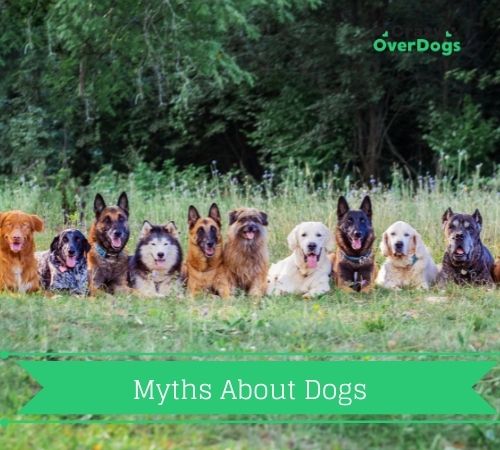Some people call them myths and some call them old wives tales. However, these myths about dogs have been around for ages and they just don’t seem to go away.
The content takes around 6 minutes to read, but if you are in a hurry, we have also included a table of contents below so you can see at a glance what the content is.
Also, make sure to check out today’s deals to SAVE money on dog products by clicking on the graphic below.
————————–
Table Of Contents
Myth 1: A Dry Nose Means a Dog is Sick:

This myth is probably one of the biggest myths around. Most people conclude that a dog with a dry nose indicates that a dog is not well and if it has a wet nose, then it is okay.
How The Myth Began:
The origins of many myths are not known, but most have their origins based on facts. This one originated around a deadly virus known at the time as canine distemper. One of the main symptoms was a thickening of the foot pads and nose, which made them become dry and hard.
When the distemper virus was widespread, a good sign was a cool wet nose. The problem still occurs, but it is not common now, due to the advanced medical knowledge that vets can use.
The Facts of The Myth:
When a dog has just woken from his sleep, the nose is usually warm and dry and this is perfectly normal. However, if it’s nose is constantly dry and crusted, it needs to be checked out with your own vet.
—————————–
Myth 2: Dogs Eat Grass To Make Themselves Vomit:

While it is true that dogs will often vomit, after eating grass, it does not infer that they did this because they felt ill and are trying to help themselves by eating the grass.
How The Myth Began:
This myth came about because dog owners observed their pets vomiting after eating grass. They assumed that the dogs did this action intentionally.
The Facts of This Myth:
Experts believe that dogs’ taste for grass is genetic and originates back to the beginning of the species. Then, the wolf pack would eat the contents of the stomach of its prey ( things such as grass).
Dogs apparently like to eat grass. Eating enough of it causes irritation which causes vomiting. In most cases eating grass is not harmless, unless the grass has chemicals on it. As always, for any severe symptoms, please check with your vet.
———————————
Myth 3: Dogs Mouths Are Cleaner Than Human Mouths:

This myth came about because dogs and most other animals lick their own wounds. In most cases, they heal faster because of it. In reality, the dog’s rough tongue had been removing any dead tissue, plus stimulating circulation, to help with the healing process.
The other side of the coin is when bacteria are introduced and also the wound is irritated, thereby slowing up the healing process.
The Facts of This Myth:
The truth is that your dog’s mouth contains plenty of germs. Most of us, including myself, forget about the stuff that it eats off the ground. In addition, dogs’ teeth do not get brushed as regularly as we brush our own. This leads to bacteria and tartar.
However, the bacteria or germs are usually specific to your dog and unlikely to cause harm to the owners or the public. Therefore, if you keep your dog healthy have it up to date on its vaccinations, which includes worming, you should have nothing to worry about, such as the next kiss and cuddle from your dog.
—————————–
Myth 4: Dogs Age Seven Years For Every Human Year:

When you really think about this myth, it does not make sense in some cases. A dog aged 15 is therefore over 100 years in dog years. Lots of dogs live to age fifteen and remain active and healthy. Also, dogs under a year can give birth.
How The Myth Began:
The myth probably came about, because someone looked at the average lifespan of dogs against the average lifespan of humans.
The Facts of This Myth:
Small breeds of dogs can live around fifteen to twenty years, while larger breeds live around eight to ten years. Generally, the rate is faster in early life but gets more slowly as the dog ages. This means that a year old dog is like a teenager, but a seven or eight-year-old dog is like a 45 -50-year-old human.
——————————
Myth 5: A Waggy Tail Indicates a Happy Dog:

It’s true that dogs do wag their tails when they are excited and happy. However, they also wag their tails for other reasons.
The Facts of the Myth:
Overall, a dog’s body language is quite complex. The tail is just one of the many ways that they communicate. The tail, indicating happiness, can also be a sign of anxiety or fear.
Therefore, you need to look at your dog’s overall body language to determine its true mood.
————————————-
Make sure to check out today’s deals to SAVE money on dog products by clicking on the graphic below. Don’t miss out.
This post contains affiliate links and I will be compensated if you make a purchase after clicking on my links.
—————————–
Estimated reading time: 6 minutes
Disclaimer: All material on this website is provided for your information only. It may not be construed as medical advice. No action or inaction should be taken based solely on the contents of this information. Instead, readers should consult appropriate health professionals or veterinarians on any matter relating to their pet’s health and well-being. The publisher is not responsible for errors or omissions.



